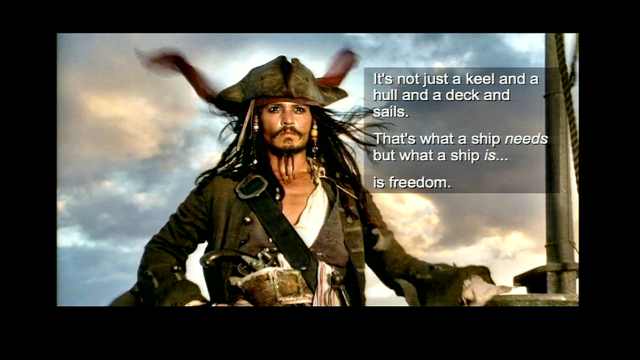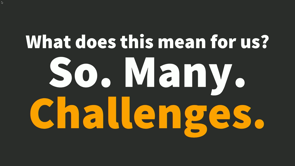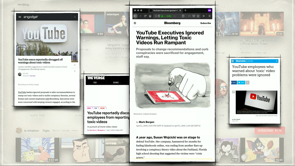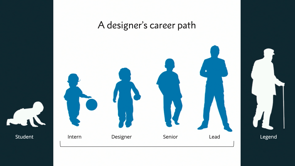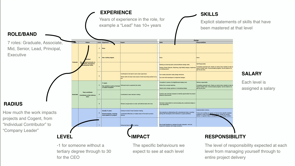Don’t overlook the bass player
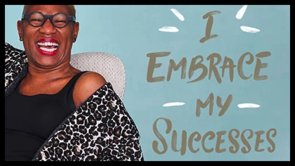
(upbeat music) (applause) - Thank you, everyone can hear me okay? Cool, all right, so thank you so much for having me. As John said, I have been to some Web Directions events in the past, but this is my first design leaders event, and it's my first time in Melbourne.
So, I'm very excited to be here.
If you're attending tomorrow's event, I am going to be talking about design systems and creativity, but today, I wanted to talk about something a little bit more personal, and a topic that's kind of near and dear to my heart. So, as I mentioned, I'm Jina.
I am a design systems advocate and practitioner. I also do a lot of stuff for the community. I'm a product design expert in the Google Developers Experts Programme, and so on. I'm also on the SAS Core Team.
So, I kinda like to do a lot of things.
A key part of all the things that I'm interested in is that I'm a hybrid, and I mostly identify as a designer, but I prefer doing it in code whenever it's possible. And because of this, I've often been forced to choose a camp.
And in my past experience, I've found that most companies don't know how to deal with hybrids.
I wrote about this topic for 24ways in 2017, and I hypothesised that, perhaps, one of the reasons that design systems are so hot right now is that, well, obviously, there's the scaling and maintainability and all that, but I think it's a really safe and comfortable place for hybrids to feel like they belong.
So, hybrids have a home in design systems.
A while back, Una Kravets had a thread on Twitter about being a hybrid, and she said that "Design and engineering "are incredibly intertwined, but companies still don't know "what to do with hybrid skillsets." And Sarah Drasner chimed in with her own thoughts. And she said, "Yeah, it's weird.
"They devalue it systemically, "can't figure out what department, etc., "but hybrids are usually the most valuable in execution." And Una replied with, "And bucketing people into silos "will only decrease their potential "and negatively impact the company overall." And I think it's important to reflect on this. It's not just about the individual's opportunities and performance, but it impacts the entire organisation.
Recently, I watched very interesting TED Talk by Adam Grant, and he's an organisational psychologist.
And in his presentation, he goes over three types of people in the workplace.
The first type of person is a taker, and he says that "Takers are self-serving in their interactions. "It's about what you can do for me?" And the second type of person is a giver, and he says, "Givers approach most interactions by asking "what can I do for you?" And then, finally, the first person is a matcher, and "Matchers try to keep that even balance of give and take, "like, I'll do something for you, "you do something for me." And through his research, Adam found that givers are on the extremes, both extremes, of the spectrum of success.
People in the organisation will often perceive these people as poor performers because they spend time helping other people instead of completing their individual work. However, givers prove to make their organisations better. His studies showed that helping, sharing knowledge, mentoring, it made business better.
It led to higher profits, customer satisfaction, employee retention, and lower operating expenses. And so, his investigation concluded that givers are the most valuable people.
And moreover, you have to protect them from burnout by decreasing the amount of takers.
And you should definitely watch the full video, because it's really fascinating.
So, I admit, I've struggled a lot with this as a design systems practitioner.
The industry sees me as pretty successful in this field, which is kinda cool, but in my own workplace, at least in my past history, I've felt invisible. And design systems might be so hot right now, but in very large companies, it can be very thankless work.
So, last month, I attended a workshop at Google called I Am Remarkable.
And the workshop aims to empower women and underrepresented groups to discuss their achievements. And the goal is to encourage people to talk about their achievements, so they're more able to ask for promotions with confidence. And the facilitator mentioned the often-referenced Hewlett-Packard stat that men ask for promotions when they meet 60% of the requirements, while women tend to wait until they reach 100%. And I pondered it, and I realised that I have never asked for a promotion.
And I know this is an enormous mistake in my career, in my life.
Believe me, I will definitely do better next time I take job, but I have anxiety around promotions and performance reviews.
And I'm going to be very, my voice is already shaking. I'm not going to cry, but I'm going to be very vulnerable right now. Is that cool? I want to talk about some of my past work history. And I've been kind of holding some of this in for a long time, but I feel like it's a good time to talk about it. So, after a few design agency gigs, I joined Apple in 2007 as a front-end UI engineer on the online store, and I led the HTML and CSS architecture.
I basically moved it from the spacer, GIF-ridden, table-based layout that it was to a web-standard, scalable, CSS architecture. And I didn't just have my own team's work.
I also got sequestered by the marketing team to help them with their product-launch pages and their CSS needs.
It was, basically, an all-hands-on-deck situation. So, I got burned out, and I didn't have much support at the time. And one time, I even had to come back into the office, when I was supposed to finally have a vacation day, and I cried.
I cried a lot, and I actually did tell somebody I was thinking about leaving.
The next day, I found flowers and a Starbucks gift card on the desk, my desk, from our VP, and she expressed her thanks.
I received a raise, bonus, and promotion, and that was the first time I had ever received a promotion. I didn't ask for it.
I just got one.
And so, after about a year, I switched to the UX team, because I was missing doing design.
So, I went from being the front-end architect to being the visual interaction designer.
And it was super-exciting for me, because I always wanted to be able to say that I was a designer at Apple.
And I envied the beautiful designs that I received from other people that I had to build.
And now, I would be the one sending the designs. But I wasn't quite, I guess, like in a capacity where I felt like I had a lot of true design leadership at that point, because really, what I was doing was receiving wireframes from other interaction designers and then PhotoShopping them to be pretty.
(laughs) That was basically my job.
But I really got into it.
That's where I really honed my craft of UI and understanding componentry and trying to do things in a scalable way, because I didn't want to design the same button over and over again.
So, I got really into it, and I was doing style guide work and all that stuff. I was also, at that point in my career, beginning to get asked to speak at conferences and blog. And I was told that I was not allowed to do that because I work for Apple.
And even though I was only talking about HTML, CSS, or design and nothing to do with Apple, I was told I shouldn't do that.
And so, I told them, well, if you ask me that, I'm going to leave.
And so, a week later, I was offered a promotion with a raise, my first RSU award, because I didn't get any when they hired me, and the caveat was that this is for you, but you have to stop blogging, and you have to stop speaking.
So, for the duration of my two-week notice that I gave, I had my second promotion.
(laughing) So, fast-forward (applause) Thank you. (laughs) Fast-forward about five years later.
I was product designer at Salesforce for a consumer-focused app that they had at the time, and then the core UX team noticed my work and asked if I could join them, so I could bring my design systems expertise to the team. And it was really good timing because right after that, the productivity app I was working on got sunset. So, I transferred, and one of the perks that came with that transfer was a promotion.
So, now I was senior product designer.
And then, a year or so later, one of my teammates was promoted to manage the team, since the previous manager left.
And this new manager was awesome and supported me and had my back, but after about a year, he also decided to go.
And he said that his last big deed that he wanted to do before he left was to see me promoted to lead. And so, he asked me to write down all my accomplishments, and obviously, the Salesforce Lightening Design System was a huge one, but in the type of work I was doing, my output was often other people's output.
I was in meetings.
I was conducting office hours.
I was holding court on advisory boards.
I paired with product designers on their specs and documentation.
I was mentoring my teammate in HTML and CSS, and there was all this side work that I was asked to do because I had some visibility in the community. So, I was running our Salesforce UX blog, our Twitter account, our Dribbble accounts. I was managing our sponsorships for design events, hosting meetups.
Now, that kind of stuff, I can show metrics for. And so, my manager was very sincere and candid with me, and he said that some of the leaders questioned whether I deserved the promotion. They didn't see me launching consumer-facing features, and the engineers didn't see me shipping much code. And while he thought that the metrics on all the community and social work that I was doing would be enough to show value, it was still very contentious.
And so, my manager told me that he told them, "Jina's the bass player.
"You need the base player.
"She's providing the foundation and support "our organisation needs." And it worked.
I got the promotion.
And that was the fourth and final time I received one, and in all cases, never had to ask for it but different circumstances led to those.
So, after that manager left, newer managers came. Teams got restructured.
Priorities changed.
The team got siloed.
No one knew where to put me, and in the end, they decided to keep me on the team, but the team had pivoted to being 100% development. All the other designers got moved off onto another team, and when you have a lead title, you have to lead. And since out team already had enough design leads, I couldn't lead there.
And since the design team that got got formed already filled all their headcounts, they didn't have a place for me either.
And they hired somebody new to come in and handle all the community and the social stuff that I was doing.
And please understand that I loved my job at Salesforce. It was the best job I ever had.
Things were really awesome when hybrids were embraced and accepted, but when newer folks came in and didn't know what to do with people like me, it was time to go.
And when I originally joined the team, that team, in 2014, there was a guy already on it, and he was a very talented visual designer. And for the longest time, he carried the weight of the entire organisation when it came to visual design, until, of course, they hired new people later on. So, all the interaction designers across this whole organisation were enlisting him for help to make their work look beautiful, and they got the praise.
They got the patents.
They got the promotions, and as of last time I inquired, which was just a few weeks ago, he still hasn't received a promotion in six years. So he was a drummer.
Or maybe he was the bass player and I was the drummer. I don't know, but either way, neither of us were lead singers. (laughs) And I've been waiting to talk about this.
Obviously, I'm still really good friends with the team. My really good friend, Stephanie Ruis, runs that team now, and she's incredible, and I do miss them a lot. But the reason I bring this up right now is that it's essential to discuss, and this message is what I wanted to bring to design leaders at this design leaders event. And the problem doesn't only lie with Salesforce, Apple, or me.
When I was at Amazon, our product organisation, for the particular product I was working on, was engineering-led, and so in this case, the entire design team, which were like six to seven people, were bass players. We weren't partners.
We were service providers, and I'm sure many of you have been there, or maybe you're dealing with it now.
So, right before my flight over here, I posted a poll on Twitter.
I don't know if you saw this, but it was just for fun, and I asked, who is most important in a band? And the choices were a singer, lead guitarist, drummer, and bass player, and Twitter only allows four options.
And when I landed, I was not surprised to see that singer won.
But all the folks that chose drummer or bass player had very very similar reasons, that they were the foundation.
And I loved this comment by Jeremy Wagner where he said, "The bass player for sure.
"I was a rhythm guitarist for a few bands, "and I can't tell you how much a great bass player does "to hold the band together during a performance "and how often they've saved my ass." I normally don't cuss when I do speeches, but these are quotes, so (laughs).
And so, now, of course, the way I worded that poll was not ideal, because in truth, a great band should put value in all the members, as they all contribute and create the music together. And Mandy Michael said, "Every part of a band plays a role and is important, "it's together you create you create amazing music, "but I feel like if you take away the drums "there is no steady beat, there is no guiding force. "It's the foundation, kinda like HTML." (chuckling) So, the various members are all talented and skilled. So, design leaders, are you overlooking your drummers and bass players for opportunities and promotions? A little while back, an article came out from Alex Schleifer, who's the head of design at Airbnb. And he wrote an article called, "The Way We Build. "How Rethinking the Airbnb App "Changed the Way We Approach Design." And Alex wrote about their vision to rethink how the people at Airbnb worked.
And he said, "Here's the simple truth: "You can't innovate on products "without first innovating the way you build them." Earlier in my career, I used to see the type of work I do as production design, and this was heavily inspired by the production designers I knew and the design agencies that I worked in.
They used various materials to paste up boxes and boards to show what the design would look like if it were real. Kinda like prototyping.
However, now, as my career has evolved, it's brought in to involve operationalizing, support, bridge building, and I'm sure you saw the Fast Company article recently, where they were referencing John Maeda's Design and Tech Report for 2019, and they called the article, or John Maeda, "In reality, design is not that important." It was kind of a click-baity title.
But what he did say in his report is, "I believe that the supporting role is what describes "how design can have the greatest impact "in the technology industry today.
"It's not the leading role.
"It's the supporting role.
"The role of design is not to aspire "to be a leading actor.
"It's goal should always be "to become a great supporting actor.
"Imagine a movie or TV show without any supporting actors. "It wouldn't be a particularly interesting "piece of entertainment.
"I don't believe in design led as the winning paradigm. "My primary goal in leading design is to aspire "for design to be as awesome a supporting player "as Jennifer Connelly or Mahershala Ali." So, this article, of course, received controversy on Design Twitter.
Design Twitter. (Laughs) So, there were a few different debates that I was observing. One was on the design industry's obsession with craft, and the other was on whether or not an organisation should be design led.
So, one of the arguments I saw was by John Lax on the debate of craft, and he said, "Design's obsession with craft is a problem. "I am with John on this point.
"Design is not that important." And then, Derrick Powazek gave a really awesome response that I loved, because I related to it, where he said, "And can we talk about the word craft here? "Craft is being used by a man "to put down work, and craft is very gendered "in this country as girl stuff.
"Kids do crafts, arts and crafts.
"When men do important work, they never call it craft." And he followed it with, and here I'm gonna cuss again, "But fuck that.
"I craft.
"Crafting is just something made "with your hands with careful consideration. "That's also called work, skilled work, "sometimes even important work.
"Fuck using craft as a put down, sexist bullshit." I loved that.
(applause) And another one I loved was from Dann Petty where he said, "There are designers who make things look better. "There are designers who make things work better. "There are designers who make the team collab better. "And that's OK." As for the debate on design-led organisations, I think Heather Phillips put it well.
"We shouldn't be thinking about being "design-first or development-first.
"Instead, we should be thinking "about how we can bring our paths closer together, "because we're all in this together." Claudina Sarahe spoke at the First Clarity, the design systems conference that I run, and in her talk, she discussed the concept of open borders. And she said, "Open borders are about working with people "across different disciplines.
"The idea is to keep the borders open.
"We don't want to have silos.
"It's trying to provide a way for everyone "to contribute their skills "regardless of their expertise." And one of my best friends, Mina Markham, said in her art direction presentation she gave recently, a few weeks ago, that "collaboration breeds creativity." So, to have a collaborative, inclusive environment, it's not just about including people in the workplace. Consider how they get opportunities.
How do they get promoted? Protect your hybrids and your givers, whether it be an individual or a team.
Please don't overlook your drummers or your bass players. Hire more of them, empower them, support them, promote them, and your organisation will be better for it. Thanks.
(applause) (upbeat music)





